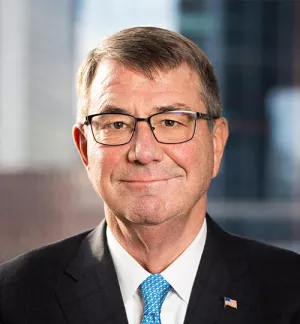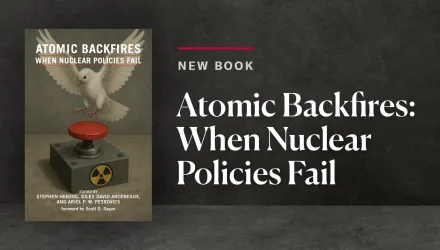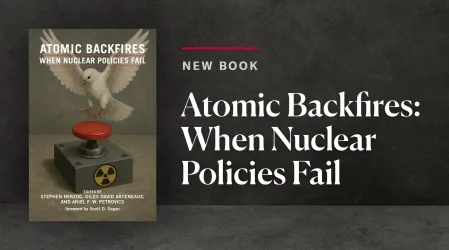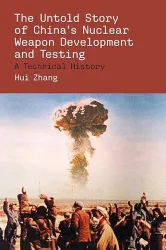The India Deal: Looking at the Big Picture
Ashton B. Carter
Co-Director, Preventive Defense Project
Kennedy School of Government
Harvard University
Testimony before the
Committee on Foreign Relations
United States Senate
November 2, 2005
Mr. Chairman and Members of the Committee on Foreign Relations, thank you for inviting me to testify before you about the benefits and costs of the deal between India and the United States reflected in the July 18 Joint Statement between President Bush and Prime Minister Singh, which for brevity I will refer to simply as the India Deal.
Chairman Lugar has charged his Policy Advisory Group (PAG), which I co-chair, with assessing the India Deal and advising him on its pros and cons, and with recommending steps the Congress should take to ensure that the final version of the deal best serves U.S. interests. The PAG, like the Committee itself, has not yet had the opportunity to hear all sides of the issue and make its recommendations. My statement today therefore reflects my own analysis and does not represent the views of the PAG.
The Need to Look at the India Deal Through a Wide Lens
Much of the discussion – and controversy – around the India Deal focuses on its nuclear aspects. Since preventing nuclear war and nuclear terrorism is the single highest priority for American national security – now and as far into the future as I can see – I have some sympathy with this emphasis. But I believe the Deal cannot be assessed within this narrow frame. In fact, when viewed as a nuclear-only deal, it is a bad deal for the United States. Washington recognized Delhi’s nuclear status in return for little in the way of additional restraints on India’s nuclear arsenal or help with combating nuclear proliferation and terrorism (that India was not already inclined or committed to give), and at appreciable likely cost to its nuclear nonproliferation objectives in other critical regions.
But it seems clear that President Bush did not view the India Deal through a nuclear-only lens, and neither should we. The United States, in this view, gave the Indians what they have craved for thirty years – nuclear recognition – in return for a “strategic partnership” between Washington and Delhi. Washington gave on the nuclear front to get something on the non-nuclear front. I agree strongly with the administration that a strategic partnership with India is in the deep and long-term U.S. security interest. A nuclear-recognition quid for a strategic-partnership quo is therefore a reasonable framework for an India Deal.
However, as a diplomatic transaction the India Deal is quite uneven. First of all, a U.S.-Indian strategic partnership would seem to be in India’s interest as well as ours. So why give them something for it? Second, the Deal is uneven in its specifics – what the U.S. gives is spelled out quite clearly, but what India gives in return is vaguer. Third, the Deal is uneven in timing – we gave something big up front, but what we stand to get lies further out in the future.
Should Congress reject the India Deal as too uneven? I would recommend instead trying to improve the diplomacy to rebalance the Deal. There are two ways this can be done: the U.S. can give less, or it can expect more. My statement takes the second approach – aiming to define a set of expectations for specific benefits to the United States from a “strategic partnership” with India.
My statement is divided into three parts: First, I describe what India got. Second, I describe what the United States should aim to get. Third, I assess the chances that U.S. expectations will actually be met.
It is premature to judge whether the expectations of this partnership as apparently foreseen on the U.S. side are shared by India and will, in fact, materialize. The Deal itself was premature. The risk with a poorly prepared diplomatic initiative is that disenchantment will set in on both sides. But with the Deal now an accomplished fact, we and the Indians must do our best to build upon it.
What Delhi Got
India obtained de-facto recognition of its nuclear weapons status: the United States will behave, and urge others to behave, as if India were a nuclear weapons state under the NPT. We will not deny it most civil nuclear technology or commerce. We will not require it to put all of its nuclear facilities under IAEA safeguards – only those it declares to be civil. It is worth noting that even if the administration wished to make India a formal Nuclear Weapons State under the NPT (which it in fact refused to do), it probably could not persuade all the other signatories of the NPT to agree to the formal change.
Beyond these technicalities, nuclear recognition confers an enormous political benefit on India. In effect, it allows India to transcend the nuclear box that has for so long defined its place in the international order, jettison at last its outdated Non-Aligned Movement stances and rhetoric, and occupy a more normal and modern place in the diplomatic world. Proponents and critics of the Deal alike agree that this is huge.
The Deal has accordingly been popular in India. Criticism from the Bharatiya Janata Party (BJP) has been narrow and technical and probably reflects regrets that a Prime Minister from the Congress Party and not the BJP secured the Deal. The other source of criticism has been leftists in the Congress Party. They are wedded to the old politics of the Non-Aligned Movement which was overtaken by the end of the Cold War, but they are unlikely to be able to block the Deal.
The Joint Statement contains a list of other items – civilian space cooperation, agricultural exchanges, HIV/AIDS cooperation, “promot[ing] modernization of India’s infrastructure,” and so on – that comprise Delhi’s long-standing list of desires. There is little in here for the United States.
Other supposed benefits of the Deal do not survive close scrutiny. Energy security, for example, is terribly important to both India and the United States. We want India’s huge population to satisfy its energy needs without contributing further to the problems of dependence on Middle East oil, pollution, and global warming. But the arithmetic does not support the case that nuclear power will spell the difference for India, though it can and should play a role. For the foreseeable future, electricity generation in India will be dominated by coal burning. Burning coal more cheaply and more cleanly will do more than any conceivable expansion of nuclear power to aid India’s economy and the environment. And nuclear power does nothing to address the principal Indian oil consuming sector – cars and trucks – since these don’t run off the electrical grid and won’t for a long time. Moreover, the type of nuclear assistance the United States is best positioned to provide (light water reactors operating on low-enriched uranium fuel) is at odds with India’s vision of a civil nuclear power program built primarily around breeder reactors.
It is also said that the Deal will require India to improve its laws and procedures for controlling exports or diversions of sensitive nuclear technology – preventing an Indian A.Q. Khan. But to my knowledge India has a good record of controlling nuclear exports (though not always ballistic missile exports). India is already bound by the U.S.-sponsored U.N. Security Council Resolution 1540 which requires such good conduct, so on paper at least Dehli has sold the same horse a second time in the Deal. In any event, the United States intends to justify the Deal’s nuclear recognition to other nations around the world on the grounds that India’s nuclear proliferation behavior is already exemplary. It will be difficult to argue this point both ways at the same time.
Missile defense cooperation is also cited in the Joint Statement. The United States has had the world’s largest and most technically proficient missile defense R&D program for many years; it is doubtful the United States can learn much from India in this field of military science, though India will benefit from U.S. knowledge. Basing U.S. missile defense radars or interceptors on Indian soil would not be of much benefit to the United States (in the way that such facilities in Japan, Great Britain, or Poland are useful), since with a few exotic exceptions the trajectories of ballistic missiles heading to targets of U.S. interest do not pass close to Indian airspace. Finally, it is possible that the administration expects India to purchase U.S. missile defense systems like THAAD to protect India from Pakistani and Chinese missile attack. Buying such defense systems would benefit U.S. industry and, through economies of scale, subsidize DOD’s own purchases of missile defenses…but it is unlikely that India will make purchases of integrated BMD systems on that scale.
What Washington Should Get
What is it then that the United States might expect from the “strategic partnership” in return for nuclear recognition and other items of interest to Delhi in the Joint Statement?
I would suggest that over the long run the United States would be expecting the following strategic benefits from the India Deal:
Immediate diplomatic support to curb Iran’s nuclear program. India will need to abandon its long-standing policy of rhetorical support for the spread of nuclear fuel-cycle activities and compromise, to some extent, its friendly relations with Iran. India’s September 24 vote with the United States and its European partners in the IAEA Board of Governors, finding Iran in noncompliance with its NPT obligations (and containing an implicit threat to refer the matter to the United National Security Council) was a welcome suggestion that India’s support in the international struggle to curb Iran’s nuclear ambitions will be firm. But India’s continued firmness in this and other urgent counterproliferation efforts will be an early test of the value of strategic partnership and its new status.
Potential counterweight to China. Though no one wants to see China and the United States fall into strategic competition, neither can anyone rule this out. The evolution of U.S.-China relations will depend on the attitudes of China’s younger generation and new leaders, on Chinese and U.S. policies, and on unpredictable events like a crisis over Taiwan. It is reasonable for the United States to hedge against a downturn in relations with China by improving its relations with India, and for India to do the same. But for now India is intent on improving its relations and trade with China, not antagonizing China. Neither government will wish to talk publicly, let alone take actions now, pursuant to this shared – but hypothetical and future – common interest.
Assistance in a Pakistan contingency. Avoiding and responding to dangers from Pakistan is another common interest that is awkward for either India or the United States to acknowledge. Pakistan, alongside Russia, belongs at the center of our urgent concern about nuclear terrorism – a concern Chairman Lugar has done so much to address. Terrorists cannot make nuclear bombs unless they obtain enriched uranium or plutonium from governments who have made these materials. The exposure of the A.Q. Khan network in Pakistan makes clear that Pakistan has to be regarded as a potential source of vital materials for nuclear terrorists – whether by theft, sale, diversion by internal radical elements with access to bombs or materials, change of government from Musharraf to a radical regime, or some sort of internal chaos. Which version of the A.Q. Khan story is more alarming – that the government and military of Pakistan was unaware of what he was doing, or that they were aware and permitted it? Either way it illustrates a serious danger. Were there to be a threat or incident of nuclear terrorism originating in Pakistan, the United States would want to act in concert with as many regional players as possible, including India.
The Pakistan contingency is even more difficult for the newly-minted “strategic partners” to acknowledge publicly, let alone to act upon. India seems intent on improving its relations with Pakistan – despite the recent bombings in Delhi and their impact on public opinion – and a rapprochement between these long-time antagonists is in the U.S. interest. The United States, for its part, has important interests at stake with the Musharraf government – among them supporting the search for Osama bin Laden and other terrorists on Pakistani territory, arresting the growth of radicalism in Pakistan’s population, and stabilizing Afghanistan – and can ill afford the perception of a “tilt towards India.” For now, therefore, the Pakistan contingency, like the China counterweight, remains a hypothetical and future benefit of the India Deal.
Joint action with the United States military in operations outside of a United Nations context. India has historically refused to join the United States military in operations outside of the context of a United Nations mandate and command. In the future, when the United States needs partners in disaster relief, humanitarian intervention, peacekeeping missions, or stability operations, the United States can reasonably expect India to cooperate. Judging from the evolution of U.S. security partnerships in Asia and Europe (especially NATO’s Partnership for Peace), anticipation of joint action can lead first to joint military planning, then progressively to joint exercises, intelligence sharing and forging of a common threat assessment, and finally to joint capabilities. This is the path foreseen for a deepening U.S.-India strategic partnership in the defense field.
Military access and basing. There could be occasions when access for and, if needed, basing of U.S. military forces on Indian territory would be desirable. At first this might be limited to port access for U.S. naval vessels transiting the Indian Ocean and overflight rights for U.S. military aircraft, but in time it could lead to such steps as use of Indian training facilities for U.S. forces deploying to locations with similar climate (the way German training areas were used for forces deploying to the Balkans).
Preferential treatment for U.S. industry in India’s civil nuclear expansion. The authors of the India Deal might have anticipated preferential treatment for U.S. industry in construction of Indian nuclear reactors and other civil power infrastructure made possible by the Deal. But there are two barriers to realization of this U.S. benefit. First, the United States must secure preferential access for its nuclear industry at the expense of Russian and European suppliers who are also seeking access to the Indian market. Second, the United States will also need to persuade India to focus its nuclear power expansion on light water reactors, not the exotic and uneconomical technologies (e.g., fast breeders) that the Indian nuclear scientific community favors. This benefit should therefore not be exaggerated.
Preferential access for U.S. defense industry to the Indian market. India is expected to increase the scale and sophistication of its military, in part by purchasing weapons systems abroad. In view of its concessions in the India Deal, the United States can reasonably expect preferential treatment for U.S. vendors relative to Russian or European vendors. Early discussions have included the F-16 and F-18 tactical aircraft and the P-3C Orion maritime surveillance aircraft.
Additional contributions to nuclear nonproliferation from India’s nuclear program. Finally, many commentators and nonproliferation experts have recommended that Congress urge the administration to pursue Indian agreement to certain additional steps, not spelled out in the Bush-Singh Joint Statement, to “even up” the nuclear portion of the Deal. These proposed additional steps by India include: agreeing to cease production of new fissile material for weapons (as the Nuclear Weapons States have done); agreeing to forego indigenous enrichment and reprocessing for its civil nuclear power program in favor of the international fuel cycle initiative proposed by President Bush in February, 2004; separating its civil and military nuclear facilities permanently and in such a manner that all reactors producing electricity are declared “civil,” joining the Proliferation Security Initiative, and so forth.
Will the United States Get the Benefits of the India Deal?
The list above is a very substantial – even breathtaking -- set of potential benefits to the United States of a strategic partnership with India. How realistic is it?
Some of the items on this list reflect joint, common interests of India as well as the United States. The United States might therefore have had many of these benefits without having to pay the nonproliferation costs associated with nuclear recognition for India.
Most of the items on the list are also hypothetical and lie in a future that neither side can predict – this is certainly the case with regard to the China counterweight and Pakistan contingency items. Other items on the list, like Iran’s nuclear program, will unfold sooner. The United States can certainly hope that India will behave as a true “strategic partner” in the future across all the items on this list. But I believe we may also find, when we ask India to do something they are reluctant to do, that we come to regret having played our big diplomatic card – nuclear recognition – so early in the process.
India, as befits a great nation on its way to global leadership, will have its own opinions about this list. Some American proponents of the India Deal have compared it to Nixon’s opening to China – a bold move based on a firm foundation of mutual interest, but more a leap of trust than a shrewd bargain. Mao and Nixon, however, had a clear and present common enemy – the Soviet Union – not a hypothetical set of possible future opponents. But the real difference between the Nixon/Kissinger deal and the India Deal is that India, unlike Mao’s China, is a democracy. No government in Delhi can turn decades of Indian policy on a dime or commit it to a broad set of actions in support of U.S. interests – only a profound and probably slow change in the views of India’s elites can do this. India’s bureaucracies and diplomats are fabled for their stubborn adherence to independent positions regarding the world order, economic development, and nuclear security. Proponents of the India Deal suggest that these positions will yield to the grand gesture of nuclear recognition by the United States. I believe this expectation is naïve. Americans view the change of long-standing and principled nonproliferation policy to accommodate India as a concession. India views it as acknowledgement of something to which they have long been entitled. This is not a durable basis for a diplomatic transaction.
Mr. Chairman and members of the Committee, it is therefore premature to tell whether the United States will achieve security benefits from the India Deal that outweigh the costs. That means the Deal itself was premature. At this point, the United States, including the Congress, can only do its best to ensure that its benefits are fully realized -- by both parties.
Please see the pdf below for the full text of Dr. Carter's testimony:
Carter, Ash. “The India Deal: Looking at the Big Picture.” November 2, 2005





